I am not sure who introduced me to La Vieille for the first time, way back in the late 1980s. She was living (existing rather) in what was known as the Pointe Noire Zoo in the Republic of Congo. It had been built, in the French colonial era, as a holding station for wild animals destined for zoos in Europe. Sometimes orphaned chimpanzees were put there after their mothers had been shot for bush meat. But by the time I went there, these infants had been rescued by an expat, Madame Jamart, and La Vieille was one of about 5 older individuals. We did not know the previous histories of any of them. All were emaciated, more or less starving, no one was paid to care for them. They were desperate for food. While I was there, something happened that haunted me like a scene from a horror movie: there was a sudden downpour, rain beating on the corrugated iron roofs of the cages and the chimpanzees, desperate for water, were reaching out as far as they could, trembling with the effort, but unable to catch even a single drop. I knew I had to do something. Madam Jamart said she would go each day and give them some food and water until I could find someone who would take over their care.
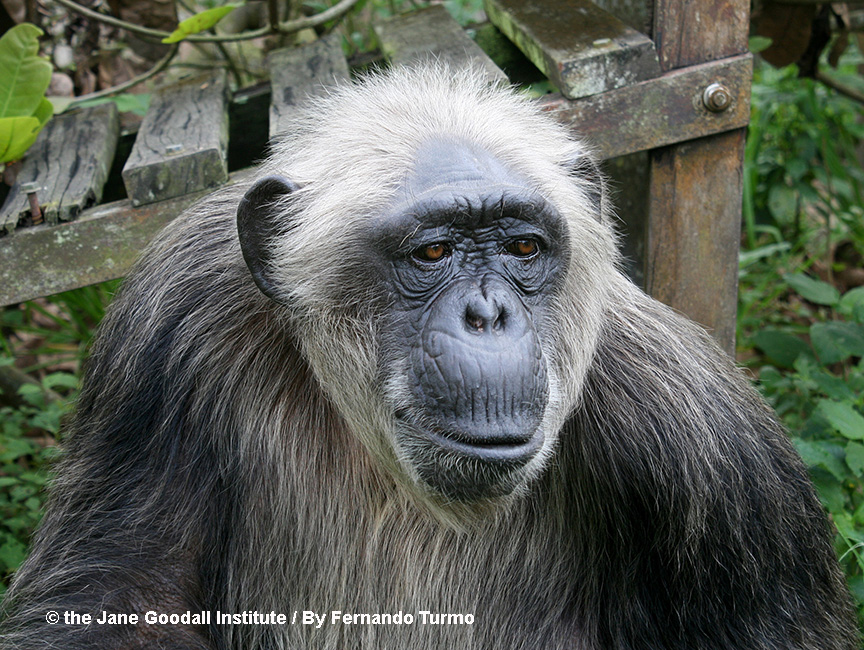
La Vielle at the JGI Tchimpounga Chimpanzee Rehabilitation Center
At that time the oil and gas company, Conoco, was exploring for oil on its concession on the coast. The project manager agreed to provide enough money to hire someone to take food to the chimps each day. And eventually we found a young woman, Karen Pack from the UK, who volunteered to go to Pointe Noire and look after them.
I was there for some days during that visit, and every evening I went with Rod MacAllister of Conoco to visit the chimps. But it was La Vieille who became my friend. The extraordinary thing about La Vieille was the fact that her cage door was broken, swinging on its hinges. There was nothing to prevent her leaving her tiny concrete cell – nothing but her own psychological inability to step into the outside world. At first she shrank away from human contact. But after a few days she let me groom her. I took one of the chimpanzee picture books, and she watched and listened as I read each page and showed her the photos.
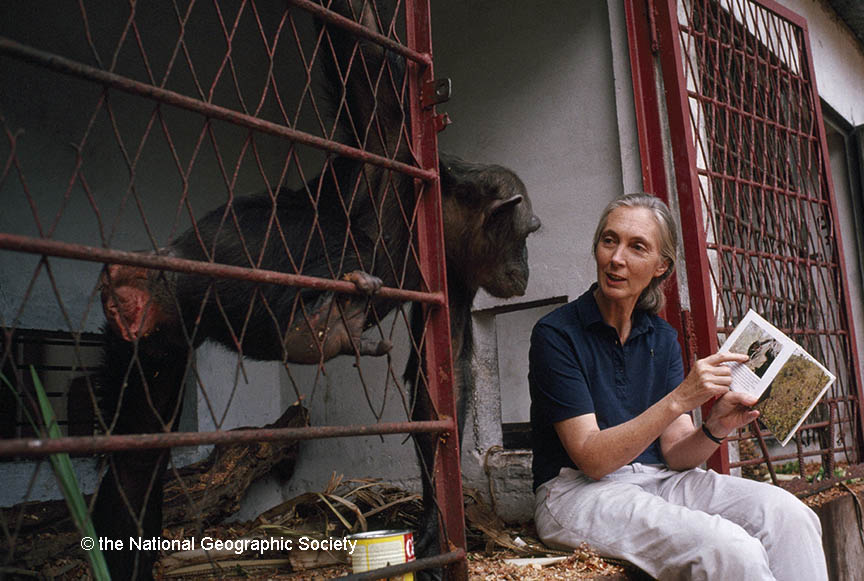
Conoco agreed to find land and build a sanctuary to house not only the orphans from Pointe Noire, but also those from the Brazzaville zoo. I was not there when, sometime in 1993, La Vieille was transported, by road, to the newly built sanctuary. When I next visited I was introduced to the completed sanctuary. An electric fence surrounded a large patch of forest where the chimpanzees spent the day, along with their caregivers. At night they returned to the main building where they got substantial dinners before settling in for the night. This building consisted of a large rectangle of earthen flooring, where most of the younger orphans slept together on a large central platform, often constructing nests of dry grass. Some chose to climb up and sleep in hammocks. The older individuals slept in compatible groups of two to four in spacious sleeping rooms that opened off this large central space. In the morning, after a large breakfast, the door to the outside was opened and the chimpanzees, with much screaming and excitement, set off for the trees. All except for one.
La Vieille remained in her sleeping room. The door to the central building was wide open. Her night companions had left. La Vieille sifted through the remains of breakfast, climbed onto her platform, and idled away the day until supper, when the others returned. The staff tried to lure her out with her favorite food, but nothing worked. She would not leave the safety of the cage. For just over two years this was the pattern of her life.
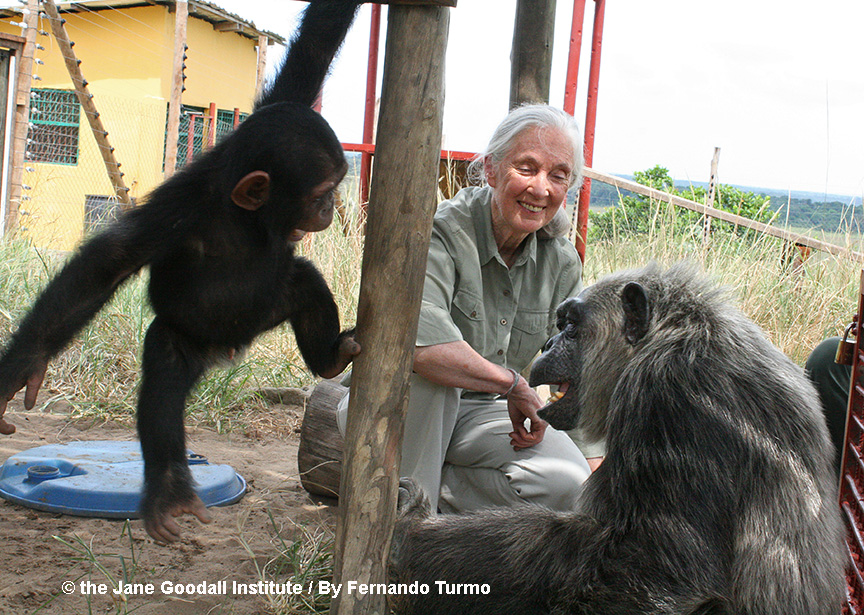
Jane Goodall with LaVielle and her new little friend at the Tchimpounga Chimpanzee Rehabilitation Center in the Republic of the Congo.
During one of my visits I went down to visit La Vieille and decided to stay with her, watching from outside her sleeping room. All the other chimps were in the outside space, mostly in the forest. La Vieille was just sitting. Suddenly her hair began to bristle. Her breathing quickened, she was sitting opposite the open door. She began rocking back and forth, her hair stood totally on end, and she suddenly lunged forward until she was level with the opening – and then, abruptly, she stopped. It was as though she had encountered an invisible barrier. She was visibly roused, still breathing fast. Gradually her hair became sleek. She climbed onto her shelf and there she sat for some 30 minutes. I waited.
Suddenly the whole process was repeated. The slight bristling, the rocking, the lunge towards the doorway and the abrupt stop. And then she sat for another half hour or so. I was determined to see this thing out, and I waited – and my patience was more than rewarded. Because the third time SHE DID IT!!! She lunged towards – the through – the door. And as she did so she quickly glanced up and moved to the side. Once out she sat on the concrete ledge for at least 10 minutes. And then, moving very carefully, she walked slowly along the whole length of the building. Between one sleeping room and the next the bars protruded beyond the walls. At each of these places she stopped for a while. She stood upright and holding onto the bars, carefully stepped around and back onto the cement ledge.
She reached the end. To cross to the opposite side of the enclosure she would have to have stepped onto the sandy floor and that, of course, was just not possible. And so, after awhile, she began the journey back to her place of safety.
I was so proud of her. I felt so privileged to have been the first person to see her courage. I went and fetched some special food and made much of her.
It was the Congolese staff who finally persuaded her to step onto the sandy floor. Each day they created roads of straw and burlap bags over which she had to walk to reach items of favorite food. Then they left small patches of sand between the bags and straw. And gradually, she managed to take first one, then two, then three steps on the dreaded sand. They helped her overcome her phobia of who knows how many years.
Much later she began to spend time with Gregoire, my other old friend who had moved to Tchimpounga from Brazzaville zoo during the civil war. And when Rebeca and Fernando built a special outdoor enclosure, just for the two of them, finally, she was walking freely on grass and under a tree. I spent hours, during my bi-annual visits, sitting in there with my two old friends, just hanging out, grooming and being groomed.
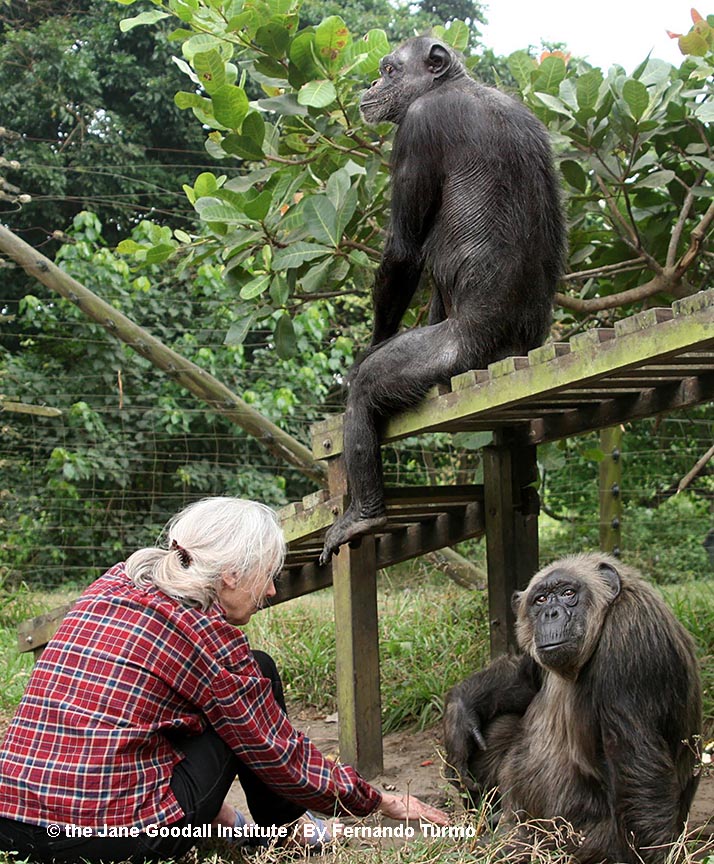
Jane Goodall with Gregoire and LaVielle at the JGI Tchimpounga Chimpanzee Rehabilitation Center.
La Vieille and Gregoire did not really interact, but they were there, together. La Vieille remained mostly sedentary, not easily stimulated into expressions of excitement. She still enjoyed the magazines I took her – her delight was to hold them and turn the pages. She did not look at the pictures, just turned the pages. She would get to the last page and start all over again.
In 2009, Gregoire died and I heard distressing reports of how she screamed and screamed. Fernando describes her reaction in the stories from Tchimpounga, and it was clear that she was overcome with grief. For although they had seldom interacted they had been together for years.
After this, La Vieille was even more listless than usual, and finally it was decided to move her to an enclosure with infants. Chantal reported that in fact, she became a wonderful foster mother!
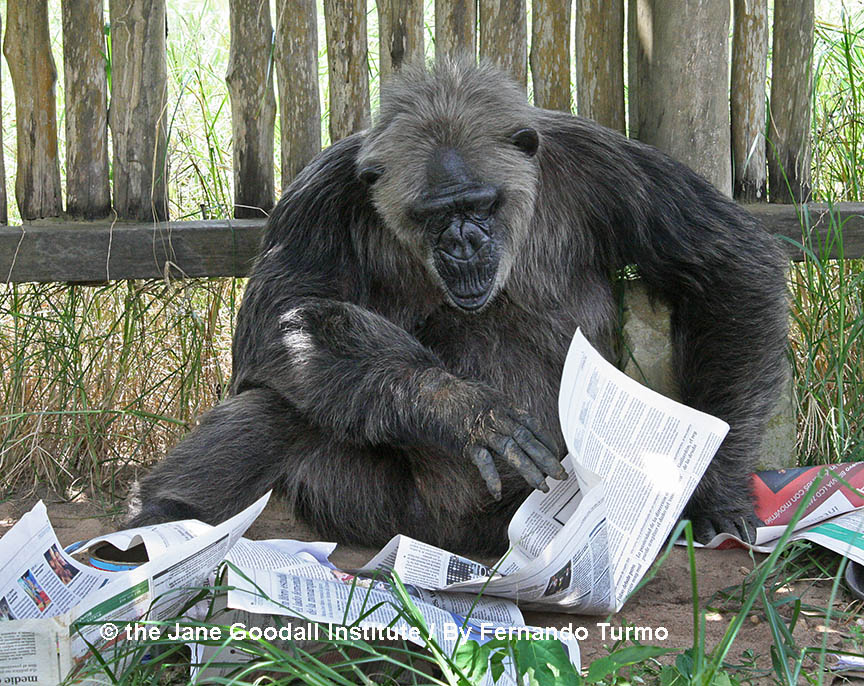
LaVielle reads the newspaper
When I visited in 2010, La Vieille was adoptive mother to infant Likuaka who had arrived half dead, riddled with parasites. Rebeca told me it had been very difficult to cure him, and during that time she didn’t want him in with the other infants. So he was introduced to La Vieille. It was love at first sight! When I saw them it was clear that they had become inseparable, and I was so happy to see her in the role of a mother.
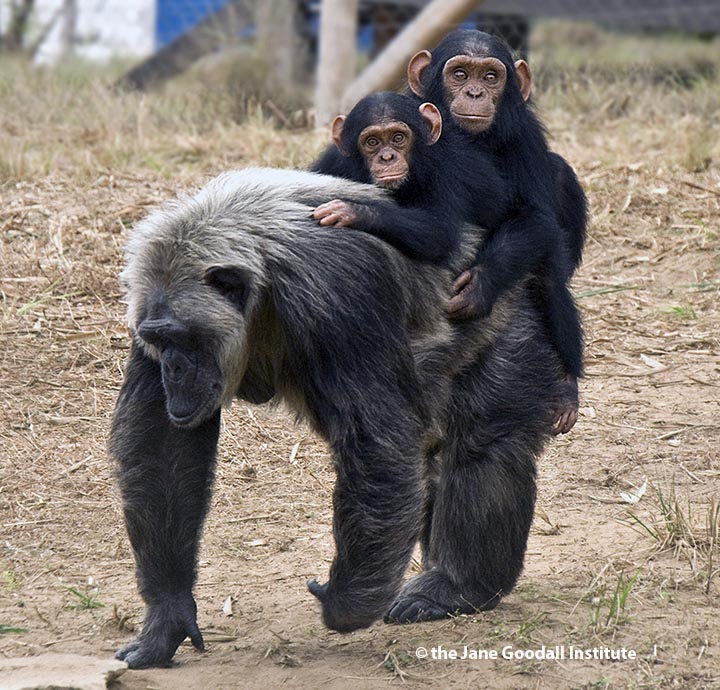
LaVielle plays with orphan babies at the JGI Tchimpounga Chimpanzee Rehabilitation Center
Three years later, during my next visit, I went in to sit with La Vieille as usual, but found it hard to interact with her as her adoptive son, now fully recovered, behaved like a little brat. She was amazingly tolerant of him as he bounced onto her, grabbed at her hair and hands, stamped on her as he swung overhead. But when she walked off he was onto her back in a flash, clinging and dependent. Knowing how I treasure my moments with La Vieille, Rebeca distracted Likuaka for a while and I sat peacefully leafing through a magazine with the old lady. Then, suddenly, Likuaka rushed over towards us but stopped suddenly when he trod in some feces – something which chimpanzees hate to do. He limped over, holding up the soiled hand, sat beside me – and vigorously WIPED HIS HAND ON MY SHIRT SLEEVE!!!!
I last saw La Vieille during my 2015 visit. She was still with her young friend, and still seemed her usual low key self. But her right hand was grotesquely swollen. It was a tumour. Rebeca said that an operation would be dangerous, and La Vieille did not appear to be in pain. She still used the hand, and paid it no special attention. I sat with her, as usual, just hanging out. I did not know that it would be the last time I would see her. I was devastated when I heard the news that she had died. I had known her for so long, loved her so dearly.
I received this moving description of her passing from Fernando Turmo.
“She was lying on the floor of her dormitory, on a lot of grass cut by caregivers. She had lost a lot of blood and was weak. I had never seen La Vieille like that during my eleven years at Tchimpounga. No one wanted to say it, but everyone thought that her end was near. She reminded me of my poor grandmother, lying on her bed. I took her hand and it was a little cold. She looked at me in a disturbing way, it seemed she wanted to tell me something with those sad eyes. We had been together so many times, and we shared so many anecdotes that will remain engraved in my soul forever.
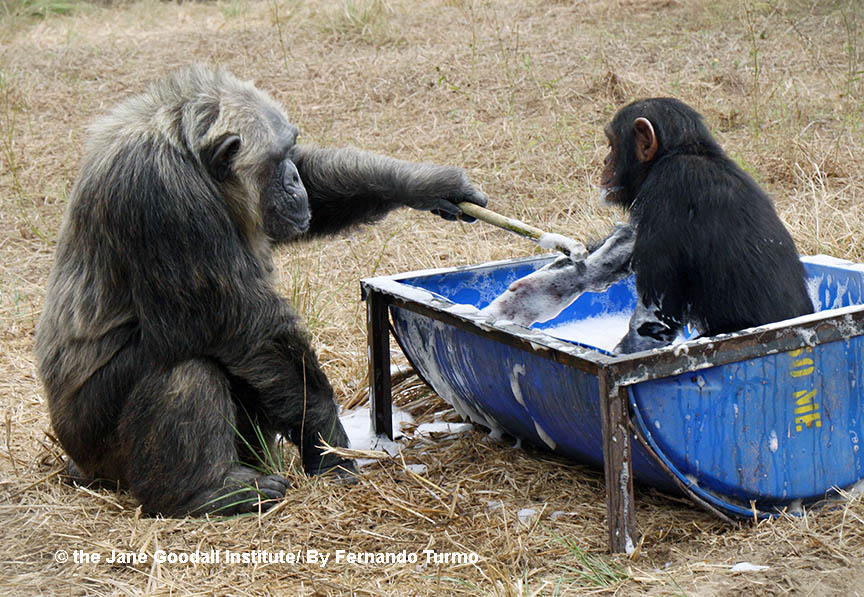
LaVielle plays with baby Mokolo at the JGI Tchimpounga Chimpanzee Rehabilitation Center
It was a long night. La Vieille was surrounded by our veterinary team. Cristel and Chantal were there as well. These two women did so much for her during her lifetime. This looked like a family, all suffering together. La Vieille was sedated and medicated with a lot of medicines that could do nothing for saving her life. While I was at home somebody phoned me; the life of La Vieille had ended. As with my grandmother, I didn’t go to see her dead. It seemed too hard for me.
I’m proud of all that we did for her during all these years. Not only Jane and staff, also JGI donors and partners around the world. All together gave her the best for a better life at Tchimpounga sanctuary”
One of the friends of Tchimpounga, Becci Crowe, fell in love with La Vieille. Becci is a wonderful artist, and she created a wonderful portrait. She is honored to have it reproduced here. It is a fitting tribute to a chimpanzee who went through so much in her life, and made such an impact on so many people and chimps, becoming a mother to orphans and a kind soul toward all.
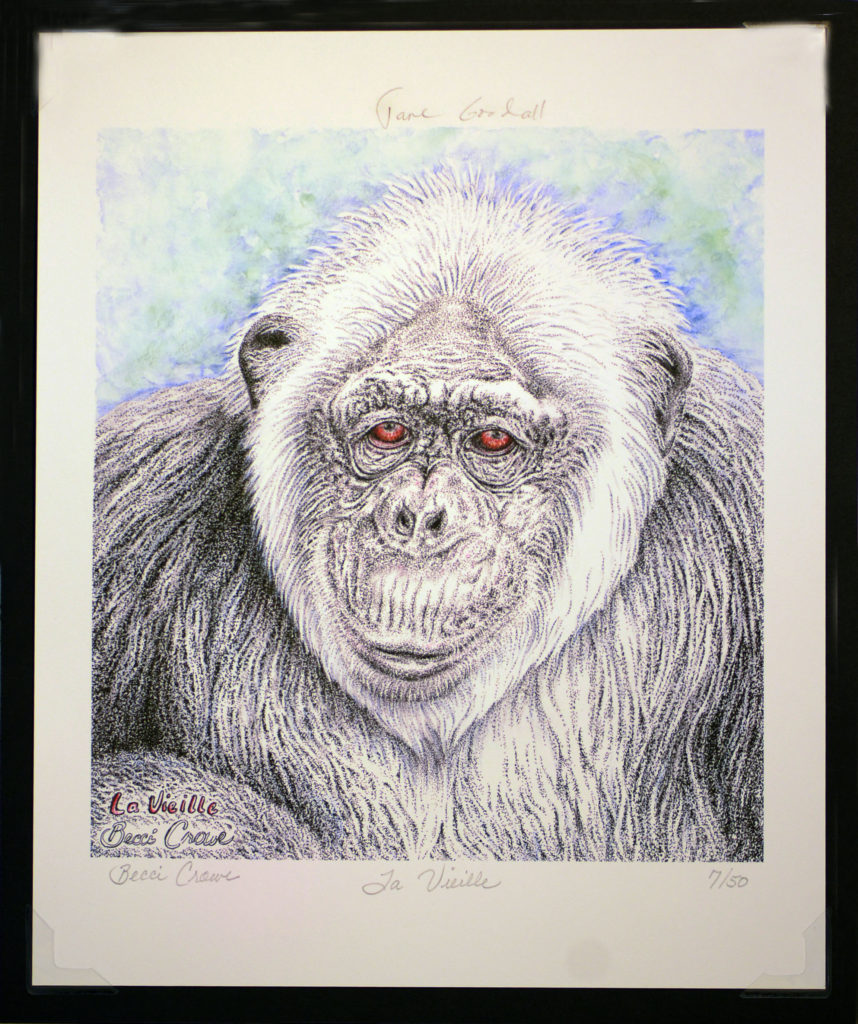
Rest in peace, La Vieille, old friend.
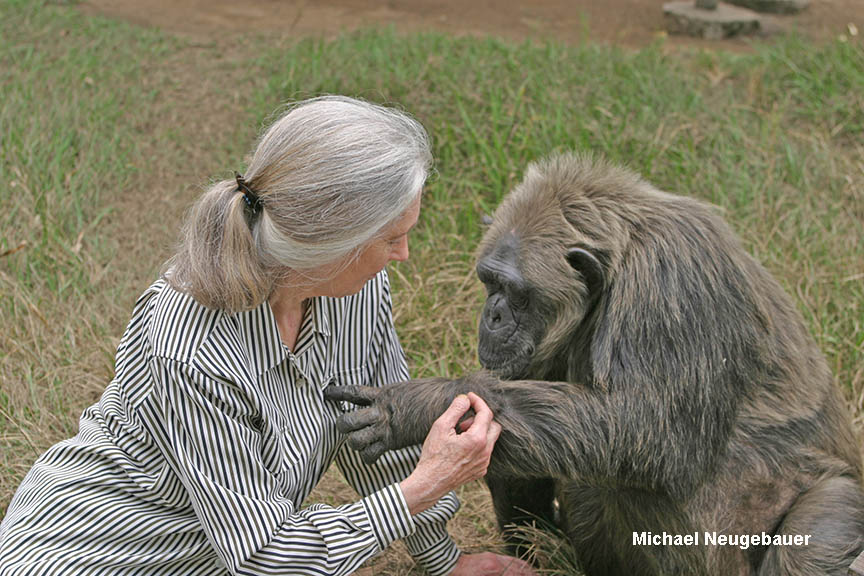
Dr. Jane Goodall with chimpanzee Lavielle at Tchimpounga Sanctuary in Pointe Noire, Congo.
More from the Chimpanzees of Tchimpounga…

Orphan Mbebo tries new foods at the JGI Tchimpounga Chimpanzee Rehabilitation Center
To help save chimpanzees like La Vielle at Tchimpounga Chimpanzee Rehabilitation Center, consider becoming a Chimpanzee Guardian here. Your donations allow us to keep our promise to never turn away a chimp in need, and to keep delivering expert care to our nearly 150 chimps.
- Bio card with photo of one of Tchimpounga’s chimpanzees
- Custom Chimpanzee Guardian certificate
- Exclusive art print
- Large plush chimpanzee
- JGI logo bumper sticker
- Monthly updates and stories about the chimpanzees of Tchimpounga
- Special invitations to webinars and events with JGI staff
- And the knowledge that your support is saving lives!

The Jane Goodall Institute is a global community conservation organization that advances the vision and work of Dr. Jane Goodall. By protecting chimpanzees and inspiring people to conserve the natural world we all share, we improve the lives of people, animals and the environment. Everything is connected—everyone can make a difference.








